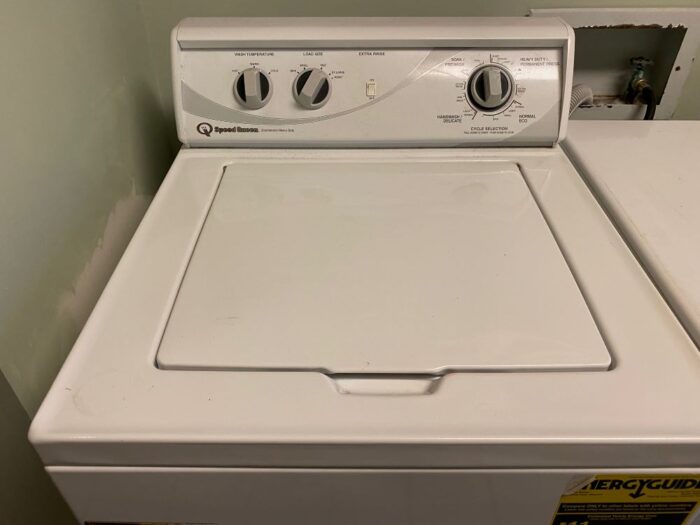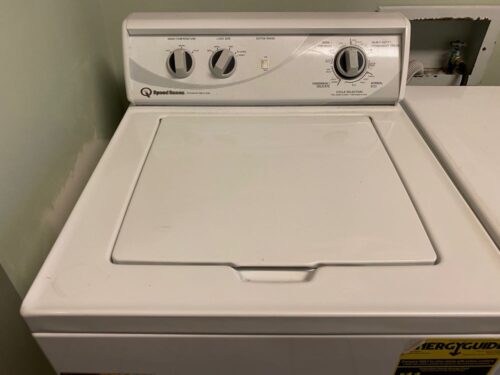Washing machines are not quiet. But they do not have to sound like cement mixers either. Grinding noise from your washing machine can be fairly easy to diagnose with a little patience, some basic tools, an owners manual, and some idea of where to start looking.
We have no control over the first 3, but we can certainly help with the ‘where to start looking’ part. Our list includes the most likely possibilities–not necessarily the easiest to repair.

8 Causes of Washing Machine Grinding Noise
Washing machines are made up of a lot of parts, many of which have to move in multiple directions and at speed. Things can wear our or get broken. Here are some of the more obvious suspects when your machine starts grinding.
1) Worn Bearings
Although bearings are fairly long-lasting, they do wear out. Or dry out. The main bearings in your washing machine are the tub bearing kit that is positioned at the rear of the tub. Even if only one bearing seems damaged, replace everything. Which consists of an inner and outer bearing and a seal.
As a DIY project this is fairly time-consuming and intricate because the entire tub needs to be removed. This means removing and/or disconnecting almost everything inside the cabinet. Then the outer tub needs to be removed from the inner tub. Re-assembling the tubs requires not only the bearing kit, but a new gasket for the outer tub.
The following YouTube video provides step-by-step instructions on how to do the job. Or you might want to watch it before committing to changing your own washer’s bearings.
2) Drive Pulley Damage or Strain
The drive pulley is on the back of the tub and can be accessed by removing the rear panel, or the rear of the washing machine. Once you have access to the pulley, remove the belt and take the pulley off. You can now check it for cracks, glazing, or tears. Make sure you also inspect the belt for damage. And while you are in there, spin the motor pulley a few times to make sure it moves freely.
If you find damage, replace the pulley and/or the belt. Replacing the pulley will eliminate grinding noises when the machine is agitating.
Note: The preceding video shows the location of the drive pulley, and how to remove and replace it.
3) Failed U-Joint
The universal joint is a central component to the agitation of your top load washing machine. It is a little difficult to diagnose a failed, or failing U-Joint. And if it is the problem, it is almost impossible to repair.
If the U-Joint in your washing machine is worn out, replacing it will be difficult and expensive. Many people opt for a new washing machine instead of paying to repair the part, and still have an old washing machine when finished.
Note: You will only find U-Joints in top load washing machines. They are an integral part of the agitation action in these machines.
4) Agitator Dogs are Damaged or Slipping
Agitator dogs control the direction of the upper part of your top-load machine’s agitator. They engage the teeth on the agitator’s inner surface enabling it to turn in one direction. Then they will release to allow the agitator to move in the opposite direction.
After years of use these small plastic parts will wear down, quit working properly, and you will hear a grinding noise when the machine switches into agitate-mode. These are very inexpensive parts and replacing them is a fairly simple DIY project.
It is relatively easy to remove the top of the agitator to inspect and/or replace the agitator dogs. The following YouTube video will give you some guidance.
Note: You will only find agitator dogs in top load washing machines. They are an integral part of the agitation action in these machines.
5) Stator Assembly Malfunction
The motor stator assembly works with the motor rotor to rotate the washing machine’s spin basket. It is located on the bottom of top load machines and on the rear of front-load machines.
A cracked wire in the stator can produce an error code and cause grinding noises when the machine is spinning or agitating. Stators are easy to replace, but they are fairly expensive. They rarely malfunction, so make the stator one of the last things you check for grinding.
The following YouTube video shows the replacement of a stator on a front load washing machine. The biggest difference you will find on a top-load machine is the location.
6) Motor Problems
Washing machine movements all start with the motor–pumping water, rotating the drum, running the agitator, and more. A motor with a problem can cause all kinds of issues including grinding noises.
- Motor Coupling. The motor coupling provides the bridge between the motor and the water supply. A worn or damaged motor coupling can lead to over-filling the tub with water. Too much water makes for slow agitation or spinning and grinding noises.
- Motor Control Board. The Motor Control Board is exactly what it sounds like. It must function properly to provide the electrical force required to control motor movements including starting, agitation direction, pumping, and more. If it is damaged or worn, the lack of sufficient power will help cause grinding noises.
- Motor Itself. Electric motors are one of our more successful inventions. They run for years without trouble. This does not mean they will last forever. Motors can overheat if something prevents them from turning, and bearings can wear out. Once you have access to the motor, make sure all the wires are connected and are not corroded. Check the capacitor for swelling and make sure the shaft spins freely. If you need to replace the motor, take a look at the following YouTube video for some guidance.
7) Pump Problems
If you find that the grinding noise is coming from the pump, you can probably go into a Snoopy dance. Because usually getting it out of the machine and giving it a good cleaning will solve your noise problem.
This is fairly easy to diagnose. Unplug the washing machine, then unplug the pump. Plug the machine back in and run it for a few seconds. If the noise is gone, it is a pump problem.
Note: Make sure you give the pump a good inspection while cleaning it. If you find cracked or broken impellers, you will have to replace the pump. Pumps are not very expensive. But most people do not have a spare lying around, so the washing machine may be down for a while waiting for a new pump to arrive.
8) That is Just the Way Your Machine Sounds
Some washing machines–like most GE models–make a grinding sound when starting. Many top load machines will make a knocking noise when agitating. This is the normal result of the agitator switching directions while agitating. This can be acceptable if the machine made these noises the first time you used them–and every time after.
If, after months of relatively quiet operation, the grinding starts, it is probably a sign that something is going wrong and you need to look for the problem or call a professional to deal with it.
A Few Other Parts to Consider
- Shock Absorbers & Springs. Top load washers usually have 4 shock absorbers holding up the tub and absorbing the clunks, bangs, and vibrations of operation. Take off the front and rear panels to access the shocks. Make sure they are not leaking and still work. If you find you have to replace one, you should replace all of them to have equal strength. Front-load washer drums are suspended from the sides of the machine by strong coil springs. About the only thing that can go wrong with them is breaking because of faulty manufacturing. They are inexpensive and easy to replace.
- Level. Never underestimate the importance of making your washing machine level. Every single part of the machine can be working perfectly but an off-level machine can grind and knock anyway. Once you get it perfectly level, install rubber pads under the feet to help the machine stay where it should.
Call a Professional for Diagnoses and/or Repairs
If removing the covering panels from your washing machine and dealing with a bunch of moving parts, water, and electricity has as much appeal as going 10 rounds with Mike Tyson, you should definitely call a professional appliance repair company.
Almost all repair people want to do a good job for their customers. Listen to what they have to say, and give them a chance to make your washing machine hum–not grind.
Unplug It
Unplug your washing machine before doing any work on it. Almost every washing machine has many wires and terminals inside–most of them bare. Shoving your arm inside while it is plugged in is not smart or safe.
Also, though not as life and death as electrical, turn off the taps and disconnect the water hoses. Getting soaked, mopping the floor, or damaging taps and hoses will not add to the washing machine repair experience.

